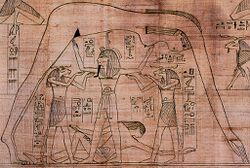Nut: Unterschied zwischen den Versionen
Adm1 (Diskussion | Beiträge) |
Adm1 (Diskussion | Beiträge) |
||
| Zeile 12: | Zeile 12: | ||
Im [[Buch_der_Himmelskuh|Buch der Himmelskuh]] wird Nut zum Reittier von [[Re]]. | Im [[Buch_der_Himmelskuh|Buch der Himmelskuh]] wird Nut zum Reittier von [[Re]]. | ||
[[Datei:Geb_Nut_Shu.jpg|250px|thumb|right|Greenfield Papyrus (the Book of the Dead of Nesitanebtashru)]] | [[Datei:Geb_Nut_Shu.jpg|250px|thumb|right|Greenfield Papyrus (the Book of the Dead of Nesitanebtashru)]] | ||
== Literatur == | == Literatur == | ||
* Ronald Wells: The Mythology of Nut and the Birth of Ra; Studien zur altägyptischen Kultur. Nr. 19, 1992, S. 305-321. | * Ronald Wells: The Mythology of Nut and the Birth of Ra; Studien zur altägyptischen Kultur. Nr. 19, 1992, S. 305-321. | ||
* Billing, Nils (2002). Nut, the Goddess of Life: In Text and Iconography. Department of Archaeology and Ancient History, Uppsala University. ISBN 9150616536. | * Billing, Nils (2002). Nut, the Goddess of Life: In Text and Iconography. Department of Archaeology and Ancient History, Uppsala University. ISBN 9150616536. | ||
* The Gods of the Egyptians, Volume 1, E. A. [[Wallis Budge|Wallis Budge]], circa 1904 | |||
== Weblinks == | == Weblinks == | ||
Version vom 17. Juni 2016, 23:47 Uhr
Die Himmelsgöttin Nut ('Nwt'; auch : Neuth) symbolisierte in der ägyptischen Mythologie das Firmament und wurde als die Mutter der Gestirne angesehen. Sie wurde zwar vielfach abgebildet, hatte aber weder einen eigenen Kult noch einen eigenen Tempel.
Nut gehört auch der Neunheit von Heliopolis an. Nach dem Schöpfungsmythos von Heliopolis ist sie die Tochter des Schu und Tefnut und eine Enkelin des Sonnengottes Atum. Mit ihrem Gemahl Geb zeugte sie die Gottheiten Osiris, Isis, Seth und Nephtys.
Im Nutbuch wird sie als Mutter des Re und Gemahlin des Osiris beschrieben:
Nachdem Nutbuch geschah die Trennung von Himmel und Erde aus einem Götterstreit, und ohne das Hochheben der Nut durch Schu wäre kein irdisches Leben möglich.
In Pyramidentexten wird Nut auch als heilende Kuh dargestellt. Sie galt als Beschützerin der Toten auf ihrer Reise ins Jenseits. Diesbezüglich wurde sie auch oft im Inneren von Sarkophagen abgebildet.
Im Buch der Himmelskuh wird Nut zum Reittier von Re.
Literatur
- Ronald Wells: The Mythology of Nut and the Birth of Ra; Studien zur altägyptischen Kultur. Nr. 19, 1992, S. 305-321.
- Billing, Nils (2002). Nut, the Goddess of Life: In Text and Iconography. Department of Archaeology and Ancient History, Uppsala University. ISBN 9150616536.
- The Gods of the Egyptians, Volume 1, E. A. Wallis Budge, circa 1904
Weblinks
- Wiki über Nut
- Mercer : Pyramidentexte, 1. NUT AND THE DECEASED KING, UTTERANCES 1-11
- [https//commons.wikimedia.org/wiki/Category:Nut_(goddess)?uselang=de Commons: Nut – Sammlung von Bildern, Videos und Audiodateien]

